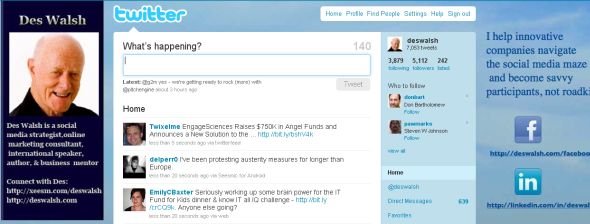New Look Twitter Borks Backgrounds, Adds Features, Challenges Branding
If you're new here, you may want to subscribe to my RSS feed. Thanks for visiting!
Picking up the other day on some tweetchat about the new look Twitter, I soon found myself watching the video “Twitter: discover what’s new in your world”.
From what I could see, the changes looked interesting enough, although I did have a moment of wondering whether the changes were going to improve our user experience, or just complicate it.
Then a bit later I noticed the message at the top of my Twitter home page, inviting me to preview the new look. So I decided to investigate.
Oh No! What Have They Done to My Background?
This was the “look” of my Twitter page at that point, i.e. before I flipped to the new look.
This is what it looked like when I clicked the new look preview option (note that at this stage the process is reversible).
My first reaction was fairly atavistic, as in “Oh no! My specially designed, branding-type Twitter background is now worse than useless!”, in that the images and text were so severely chopped.
And I thought about all the people who not so long ago had paid out good money to have backgrounds designed and wondered how they would be feeling at this turn of events.
The I thought I should get to work and find out how best to deal with the new arrangements, from a branding point of view.
How to Design a New Background
Jonathan at Banyan Branch offers data on the space now available for background design and some detailed advice on how to create a new background to go with the new look Twitter interface. I noted particularly his advice, with rationale, to use a .PNG image file rather than the .JPG format. He comments too that while our Twitter backgrounds won’t be as important as they were, a good background will still help to set a brand apart on Twitter.
Consider the New/Improved Features
Carla Young at Momeo Magazine outlines the new embedded media and related content features and the changed setup for the user profile, adding some helpful advice on that item, as follows:
Update your bio to tell potential new followers why they should click the follow button. Include personal details, not just the boring condensed version of your elevator speech.
Conclusion
I’m not convinced that I’ll be using the Twitter interface now in lieu of the Hootsuite app which is my main tool for managing my Twitter activity, but my sense is that although the borking of the backgrounds is at least a nuisance, the changes offer a prospect of a better user experience overall and the new features should be able to be used effectively enough for branding.
Des Walsh
Business coach and digital entrepreneur. With coach training from Coachville.com and its Graduate School of Coaching, and a founding member of the International Association of Coaching, Des has been coaching business owners and entrepreneurs for the past 20 years. Over the same period he has also been actively engaged in promoting the business opportunities of the digital economy. He is a certified Neurolinguistic Programming (NLP) coach, and a certified specialist in social media strategy and affiliate marketing.


Those folks like you who swear by third-party Twitter applications like Hootsuite, Seesmic, and Tweetdeck will continue using them. Folks like me, though, who use the web interface all the time are learning to adapt.
Well, I wouldn't say I *swear by* third party apps, Ari, but up till now I've found the Twitter UI rather limiting. So I am interested to see how it develops.
I've been hearing about the “new” Twitter but hadn't taken time to check it out. So glad, Des, that you introduced the info here.
It often seems inevitable that our custom branding will need retooling with each program's update. Makes you sigh, doesn't it? Still, our places in social media cannot be masked. These little blips make us more determined to shine brighter and bring greater value to the people we serve.
Given that Twitter, Facebook and other platforms are perfectly entitled to change their interfaces as much and as frequently as they like, providers of graphic enhancement services for individual businesses using those services will surely need to make such contingencies clear to clients, so they, the designers/providers don't have customer relationships damaged by the fallout from the actions of the platform owners. And for the end user it's the old “buyer beware/do your due diligence” song again.